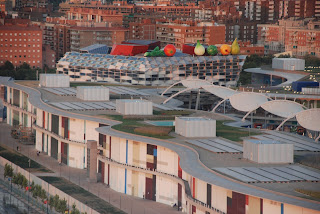
The first thing to stand out is Pabellón Puente (Bridge Pavilion), a metallic and geometric structure desgined by famous iraqi architect Zaha Hadid. Inside it, there is a display that makes you think about the enormous amount of water humans consume, how uneven is its distribution in the World and how important is to use it rationally.

My attention was drawn by this computer that made you a test and told you how many litters of water you use in one year.

Then, on the left, there was Palacio de Congresos (Exhibition Hall), a modernist building used for cultural events but closed to the general public.

At the very end lies Torre del Agua (Water Tower), with 76m, is the tallest building in the fairground.

Inside the tower, he most important thing is "Splash", a 21 meters long sculpture that represetns an explosion of water.

Among the 108 participant nations, the only pavilion that is not inside prefabricated cubic modules is, obviously, the host country. Spain had a pavilion with elegant architecture, featuring long columns that emerged from a small pond. The journey began with a spheric screen cinema, went on with a kind of Museum of water, dioramas of diverse environments and Spanish proposals on sustainability.

In the next picture you can see 3 thematic pavillions

(左LEFT) Pabellón Sed, Thirst Pavilion, an artistic display about the lack of water. It featured 2 rooms with audiovisuals.
(中CENTRE) El faro, The lighthouse, a pretty interesting pavilion for NGO's. It was built with ecological techniques for temperature isolation. Quite outstanding that it was the space that criticized the most the uneven access to clean water for poor people and it even mentioned several cases of social denounce related to water.
(右RIGHT) Agua Extrema, Extreme Water, a building of caprice architecture whose main attraction was a simulator that made visitors feel the experience of a Tsunami, a Hurricane and Flooding. It was a bit disylandesque, however, I must point out that it was among the best things in Expo. For a moment, I experiences the danger and anguish of those the survivors to those meteorologic phenomenon.

Other thematic pavilions were;
--Acuario Fluvial, River Aquarium: The largest in Europe, exhibiting the aquatic life of five rivers: Amazon, Nile, Murray Darling, Mekong and Ebro. To tell the truth, I think it was a bit flavourless and even lame. Maybe for small children is fine, but I think it is not worthy making such a long queue for something quite dull.

--Oikos: Agua y Energía, Oikos: Water and Energy: A pavilion that looks more like an Interactive Science Museum, showcasing the water as a power source.
--Ciudades de Agua, Water Cities: A photo exhibition about cities whose design is according to water. There I found this picturesque spot. The models are two Spanish friends that I meet that day and that we spent the day together. They show that in Expo there is always room for love.

Aragon, the host autonomous community (Spanish equivalent for region or state), had one of the most distinguishing pavilions. Its structure was shaped like a Basket, indeed in the nighttime they put some blow up fruit. The journey ended in a room with 8 screens showing a documentary about Aragon's natural and cultural heritage. In the next picture you see Aragon Pavilion behind the international pavilions building.

Very close to Aragon pavilion was a building that in the lower floor it had pavilions of all the Spanish autonomous communities, Andalusia, Catalonia, Galicia. Madrid and all the rest were there. In the upper floor there were institutional and sponsoring companies pavilions.

No comments:
Post a Comment